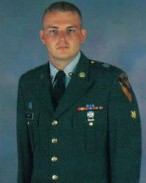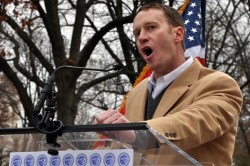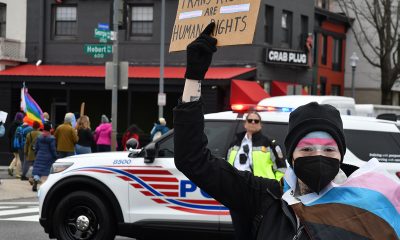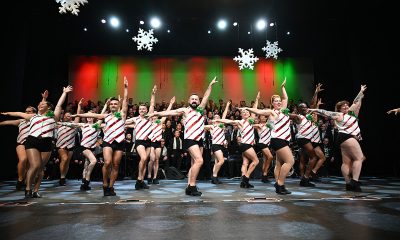National
Discharged gay troops ready to re-enlist
‘That’s the life I was destined to lead’
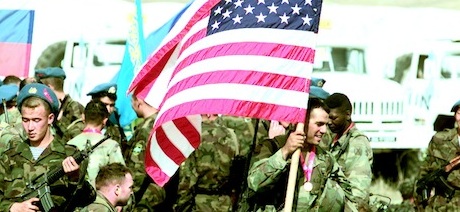
For Thomas Cook, deciding whether or not to re-enlist in the U.S. military after “Don’t Ask, Don’t Tell” is off the books is a no-brainer.
Cook, a Houston resident who was discharged in 2004 under the anti-gay law, said he “absolutely” plans to rejoin the armed forces on the day that the military’s gay ban is lifted.
“That’s the life I was destined to lead,” Cook said. “I think military service is in my blood and my past experience in the military — I absolutely loved it. I wouldn’t have changed anything about it. I come from a family of military people, and I’m looking forward to going back into the military as soon as I can — Sept. 20.”
Cook, now 29, said he doesn’t intend to enter the same field in the military that he held upon his discharge, nor will he enter the same branch of service. He served in military intelligence in the Army prior to his separation, but Cook said he plans to join the Air Force nursing field to make use of the education he has since received in that area.
On July 22, President Obama, Defense Secretary Leon Panetta and Chairman of the Joint Chief of Staff Adm. Mike Mullen certified that the U.S. military is ready for open service in accordance with the repeal law signed in December, starting the 60-day period for when “Don’t Ask, Don’t Tell” will be a thing of the past on Sept. 20.
Gay service members discharged under “Don’t Ask, Don’t Tell” will be able to re-enter the armed forces from that point forward. Some service members whose separations received media attention said their affinity for military service leaves no doubt in their mind that they’ll re-enter the military as soon as possible.
Cook, who first joined the Army in 2001, said he feels compelled to continue military service even though he was kicked out after he declared his sexual orientation. In 2003, the team leader in Cook’s company said during a training exercise he’d kill anyone in his crew whom he found out was gay. Cook reported the team leader’s remarks to his battalion commander and said the threat alarmed him because he is gay. The confession started Cook’s discharge proceedings, and he was ultimately separated from the Army under “Don’t Ask, Don’t Tell” on Jan. 20, 2004.
Seeking to rejoin the military, Cook was lead plaintiff in Cook v. Gates, a lawsuit challenging “Don’t Ask, Don’t Tell” that was filed by Servicemembers Legal Defense Network. However, the U.S. District Court in Massachusetts and the U.S. First Circuit Court of Appeals upheld the constitutionality of “Don’t Ask, Don’t Tell” in response to the challenge, forcing Cook to wait for legislative repeal before he could re-enter the military.
Cook said he bears no ill-will toward the military even though he was expelled from his position simply for stating his sexual orientation and was unable to reclaim his role through the litigation in which he was lead plaintiff.
“The organization itself has the policy in place, but the people I worked with didn’t necessarily believe in the policy,” Cook said. “I worked with people and the other soldiers that believe the same things I believed, which is anyone and everyone that is eligible to serve and is capable of serving should be allowed.”
Other service members whose discharges received prominent attention also said they intend to rejoin the armed forces after the gay ban is lifted — but aren’t feeling the same need to re-enlist on Sept. 20 as soon as “Don’t Ask, Don’t Tell” is off the books.
Alex Nicholson, executive director of Servicemembers United, is planning to re-enter the military as a member of the Reserves and, after obtaining a law degree, pursue a career as a military lawyer in the Judge Advocate General’s Corps.
“It’s still a lifestyle and a set of people that I am comfortable around and I’ve always had an affinity for,” Nicholson said. “It’s hard to explain the phenomenon and the fraternity that it is.”
Like Cook, Nicholson plans to take a different position than his previous role. Nicholson was an Army intelligence officer prior to his separation at the age of 20 under “Don’t Ask, Don’t Tell” in 2002. A fellow service member outed him to his unit after she read a letter he had written in Portuguese to a man he dated before he joined the Army.
After forming Servicemembers United in 2005, Nicholson became active in the discussion with the White House and Congress that led to legislative repeal of “Don’t Ask, Don’t Tell.” Nicholson was also the sole named plaintiff in the lawsuit Log Cabin Republicans v. United States, which led the U.S. Ninth Circuit Court of Appeals to institute an injunction this year barring further discharges under “Don’t Ask, Don’t Tell.”
Despite his plan to rejoin the military, Nicholson, now 30, said he plans to hold off on re-enlisting for about two or three years as he continues his advocacy work because he doesn’t believe being in the military while acting as a watchdog for gay troops is appropriate.
“I just don’t feel like I would be able to continue to do the job that I do by doing that,” Nicholson said. “That’s going to add a whole additional layer of complexity to the political work, or the watchdog work that we do, if I were to do something like that.”
Also planning to re-enlist is Mike Almy, a former Air Force communications officer who was discharged under “Don’t Ask, Don’t Tell” in 2006. He said he wants back in the armed forces because he has an affinity for it.
“It’s what I’ve done for 13 years,” Almy said. “I miss it, the people, the camaraderie, the mission and want to finish my career.”
After a fellow service member read a private e-mail revealing his sexual orientation and reported the information to his commander, Almy was discharged under “Don’t Ask, Don’t Tell.” He never made a public statement that he was gay, but was nonetheless separated.
Almy, 40, received significant attention as a service member discharged under “Don’t Ask, Don’t Tell” after testifying before the Senate Armed Services Committee last year against the military’s gay ban and taking on tough questioning from Sen. John McCain (R-Ariz.).
The best path that Almy said he sees for re-entering the armed forces is the resolution of the lawsuit in which he is lead plaintiff, Almy v. United States. The case, filed by SLDN and pending before the U.S. District Court of Northern California, seeks to reinstate him and other plaintiffs in the armed forces.
The case, Almy said, represents his best chance to return to the Air Force as an officer because of difficulties in the path ahead if he were to re-enlist at a recruiting station.
“It’s very difficult as an officer to go back on active duty, and that has absolutely nothing to do with ‘Don’t Ask, Don’t Tell,’ but just the fact that being separated and out for a couple years — coupled with the fact that there’s a drawdown — so that’s why we got the lawsuit in the works,” Almy said.
Almy added he’s expecting a resolution to the lawsuit in a couple of months and not the exact same position he held upon discharge, but a position that is comparable and the same rank.
Upon his discharge under “Don’t Ask, Don’t Tell,” Almy lost all the benefits he would have had if he had been allowed to retire on his own accord. His reinstatement in the armed forces would enable him to reclaim those benefits.
“I have none whatsoever,” Almy said. “That’s what we’re trying to get as well. Assuming we’re successful in the lawsuit and win, and get reinstatement, then we’ll pick up where we left off basically, so I’ll get those benefits, go on to finish my career and ultimately retire.”
The White House
Empty seats, canceled shows plague Kennedy Center ahead of Trump renaming
It would take an act of Congress to officially rename the historic music venue, despite the Trump-appointed board’s decision.

The board of the Kennedy Center in Washington, D.C., voted to rename it the Trump-Kennedy Center, according to the White House Press Office.
White House Press Secretary Karoline Leavitt announced the decision in a post on X Thursday, thanking the president for his work on the cultural center “not only from the standpoint of its reconstruction, but also financially, and its reputation.”
Speaking to reporters later that day at the White House, Trump said he was “surprised” and “honored” by the board’s vote.
“This was brought up by one of the very distinguished board members, and they voted on it, and there’s a lot of board members, and they voted unanimously. So I was very honored,” he said.
Earlier this year, GOP Rep. Mike Simpson of Idaho introduced an amendment that would have renamed the building after first lady Melania Trump, later saying she had not been aware of his efforts prior to the amendment’s public introduction.
Despite the board’s vote (made up of Trump-appointed loyalists), the original laws guiding the creation of the Kennedy Center during the Eisenhower, Kennedy, and Johnson administrations explicitly prohibit renaming the building. Any change to its name would require an act of Congress.
Trump has exerted increasing control over the center in recent months. In February, he abruptly fired members of the Kennedy Center’s board and installed himself as chair, writing in a Truth Social post at the time, “At my direction, we are going to make the Kennedy Center in Washington D.C., GREAT AGAIN.”
In that post, Trump specifically cited his disapproval of the center’s decision to host drag shows.
He later secured more than $250 million from the Republican-controlled Congress for renovations to the building.
Since Trump’s takeover, sales of subscription packages are said to have declined, and several touring productions — including “Hamilton” — have canceled planned runs at the venue. Rows of empty seats have also been visible in the Concert Hall during performances by the National Symphony Orchestra.
“The Kennedy Center Board has no authority to actually rename the Kennedy Center in the absence of legislative action,” House Minority Leader Hakeem Jeffries told reporters.
For decades, the Kennedy Center has hosted performances by LGBTQ artists and companies, including openly queer musicians, choreographers, and playwrights whose work helped push LGBTQ stories into the cultural mainstream. Those artists include the Gay Men’s Chorus of Washington, Harvey Fierstein, and Tennessee Williams.
In more recent years, the center has increasingly served as a space for LGBTQ visibility and acceptance, particularly through Pride-adjacent programming and partnerships.
That legacy was on display at this year’s opening production of Les Misérables, when four drag performers — Tara Hoot, Vagenesis, Mari Con Carne, and King Ricky Rosé — attended in representation of Qommittee, a volunteer network uniting drag artists to support and defend one another amid growing conservative attacks.
“We walked in together so we would have an opportunity to get a response,” said Tara Hoot, who has performed at the Kennedy Center in full drag before. “It was all applause, cheers, and whistles, and remarkably it was half empty. I think that was season ticket holders kind of making their message in a different way.”
The creation of the Kennedy Center is outlined in U.S. Code, which formally designates the institution as the John F. Kennedy Center for the Performing Arts.
As a result, it appears unlikely that Congress will come together to pass legislation allowing the historic venue to be renamed.
The White House
HHS to restrict gender-affirming care for minors
Directive stems from President Donald Trump’s Jan. 28 executive order

The U.S. Department of Health and Human Services announced Thursday that it will pursue regulatory changes that would make gender-affirming healthcare for transgender children more difficult, if not impossible, to access.
The shift in federal healthcare policy stems directly from President Donald Trump’s Jan. 28 executive order, Protecting Children From Chemical and Surgical Mutilation, which formally establishes U.S. opposition to gender-affirming care and pledges to end federal funding for such treatments.
The executive order outlines a broader effort to align HHS with the Trump–Vance administration’s policy goals and executive actions. Those actions include defunding medical institutions that provide gender-affirming care to minors by restricting federal research and education grants, withdrawing the 2022 HHS guidance supporting gender-affirming care, requiring TRICARE and federal employee health plans to exclude coverage for gender-affirming treatments for minors, and directing the Justice Department to prioritize investigations and enforcement related to such care.
HHS has claimed that gender-affirming care can “expose them [children] to irreversible damage, including infertility, impaired sexual function, diminished bone density, altered brain development, and other irreversible physiological effects.” The nation’s health organization published a report in November, saying that evidence on pediatric gender-affirming care is “very uncertain.”
The Centers for Medicare and Medicaid Services is now in the process of proposing new rules that would bar hospitals from performing what the administration describes as sex-rejecting procedures on children under age 18 as a condition of participation in Medicare and Medicaid programs. Nearly all U.S. hospitals participate in Medicare and Medicaid. HHS said that “this action is designed to ensure that the U.S. government will not be in business with organizations that intentionally or unintentionally inflict permanent harm on children.”
Health and Human Services Secretary Robert F. Kennedy Jr. released a statement alongside the announcement.
“Under my leadership, and answering President Trump’s call to action, the federal government will do everything in its power to stop unsafe, irreversible practices that put our children at risk,” Kennedy said. “This administration will protect America’s most vulnerable. Our children deserve better — and we are delivering on that promise.”
Those claims stand in direct opposition to the positions of most major medical and healthcare organizations.
The American Medical Association, the nation’s largest and most influential physician organization, has repeatedly opposed measures that restrict access to trans healthcare.
“The AMA supports public and private health insurance coverage for treatment of gender dysphoria and opposes the denial of health insurance based on sexual orientation or gender identity,” a statement on the AMA’s website reads. “Improving access to gender-affirming care is an important means of improving health outcomes for the transgender population.”
Jennifer Levi, senior director of transgender and queer rights at GLBTQ Legal Advocates and Defenders, warned the proposed changes would cause significant harm.
“Parents of transgender children want what all parents want: to see their kids thrive and get the medical care they need. But this administration is putting the government between patients and their doctors. Parents witness every day how their children benefit from this care — care backed by decades of research and endorsed by major medical associations across the country. These proposed rules are not based on medical science. They are based on politics. And if allowed to take effect will serve only to drive up medical costs, harm vulnerable children, and deny families the care their doctors say they need. These rules elevate politics over children — and that is profoundly unAmerican.”
Human Rights Campaign President Kelley Robinson echoed Levi’s sentiments.
“The Trump administration is relentless in denying health care to this country, and especially the transgender community. Families deserve the freedom to go to the doctor and get the care that they need and to have agency over the health and wellbeing of their children,” Robinson said. “But these proposed actions would put Donald Trump and RFK Jr. in those doctor’s offices, ripping health care decisions from the hands of families and putting it in the grips of the anti-LGBTQ+ fringe. Make no mistake: these rules aim to completely cut off medically necessary care from children no matter where in this country they live. It’s the Trump administration dictating who gets their prescription filled and who has their next appointment canceled altogether.
The announcement comes just days after U.S. Rep. Marjorie Taylor Greene (R-Ga.) advanced legislation in Congress that would make it a felony to provide gender-affirming care to a child.
The White House
As house Democrats release Epstein photos, Garcia continues to demand DOJ transparency
Blade this week sat down with gay House Oversight Committee ranking member

Democrats on the House Oversight Committee have released new photos from Jeffrey Epstein’s email and computer records, including images highlighting the relationship between President Donald Trump and the convicted sex offender.
Epstein, a wealthy financier, was found guilty of procuring a child for prostitution and sex trafficking, serving a 13-month prison sentence in 2008. At the time of his death in prison under mysterious circumstances, he was facing charges of sex trafficking and conspiracy to traffic minors.
Among those pictured in Epstein’s digital files are Trump, former President Bill Clinton, former Trump adviser Steve Bannon, actor and director Woody Allen, economist Larry Summers, lawyer Alan Dershowitz, entrepreneurs Richard Branson and Bill Gates, and Andrew Mountbatten-Windsor.
One photo shows Trump alongside Epstein and a woman at a Victoria’s Secret party in New York in 1997. American media outlets have published the image, while Getty Images identified the woman as model Ingrid Seynhaeve.
Oversight Committee Democrats are reviewing the full set of photos and plan to release additional images to the public in the coming days and weeks, emphasizing their commitment to protecting survivors’ identities.
With just a week left for the Justice Department to publish all files related to Epstein following the passage of the Epstein Files Transparency Act, which requires the Justice Department to release most records connected to Epstein investigations, the Washington Blade sat down with U.S. Rep. Robert Garcia (D-Calif.), the ranking member on the Oversight Committee to discuss the current push the release of more documents.
Garcia highlighted the committee’s commitment to transparency and accountability.

“We’ve said anything that we get we’re going to put out. We don’t care who is in the files … if you’ve harmed women and girls, then we’ve got to hold you accountable.”
He noted ongoing questions surrounding Trump’s relationship with Epstein, given their long history and the apparent break in friendship once Trump assumed public office.
“There’s been a lot of questions about … Donald Trump and Jeffrey Epstein. They were best friends for 10 years … met women there and girls.”
Prior to Trump’s presidency, it was widely reported that the two were friends who visited each other’s properties regularly. Additional reporting shows they socialized frequently throughout the 1990s and early 2000s, attending parties at Trump’s Mar-a-Lago resort in Florida and Epstein’s residences. Flight logs from an associate’s trial indicate Trump flew on Epstein’s private jet multiple times, and Epstein claimed Trump first had sex with his future wife, Melania Knauss, aboard the jet.
“We’ve provided evidence … [that leads to] questions about what the relationship was like between Donald Trump and Jeffrey Epstein.”
Garcia stressed the need for answers regarding the White House’s role in withholding information, questioning the sudden change in attitude toward releasing the files given Trump’s campaign promises.
“Why is the White House trying to cover this up? So if he’s not covering for himself … he’s covering up for his rich friends,” Garcia said. “Why the cover up? Who are you hiding for? I think that’s the question.”
He confirmed that Trump is definitively in the Epstein files, though the extent remains unknown, but will be uncovered soon.
“We know that Trump’s in them. Yeah, he’s been told. We know that Trump’s in them in some way. As far as the extent of it … we don’t know.”
Garcia emphasized accountability for all powerful figures implicated, regardless of financial status, political party, or personal connections.
“All these powerful men that are walking around right now … after abusing, in some cases, 14‑ and 15‑year‑old girls, they have to be held accountable,” he said. “There has to be justice for those survivors and the American public deserves the truth about who was involved in that.”
He added that while he is the ranking member, he will ensure the oversight committee will use all available political tools, including subpoenas — potentially even for the president.
“We want to subpoena anyone that we can … everyone’s kind of on the table.”
He also emphasized accountability for all powerful figures implicated, regardless of financial status, political party, or relationship with the president.
“For me, they’re about justice and doing the right thing,” Garcia said. “This is about women who … were girls and children when they were being abused, trafficked, in some cases, raped. And these women deserve justice.”
“The survivors are strong.”
Deputy White House Press Secretary Abigail Jackson issued a statement regarding the release the photos, echoing previous comments from Republicans on the timing and framing of the photos by the Oversight Committee.
“Once again, House Democrats are selectively releasing cherry-picked photos with random redactions to try and create a false narrative,” Jackson said.
“The Democrat hoax against President Trump has been repeatedly debunked and the Trump administration has done more for Epstein’s victims than Democrats ever have by repeatedly calling for transparency, releasing thousands of pages of documents, and calling for further investigations into Epstein’s Democrat friends,”
In a press release on Friday, Garcia called for immediate DOJ action:
“It is time to end this White House cover-up and bring justice to the survivors of Jeffrey Epstein and his powerful friends. These disturbing photos raise even more questions about Epstein and his relationships with some of the most powerful men in the world. We will not rest until the American people get the truth. The Department of Justice must release all the files, NOW.”





(Photo courtesy of the U.S. House Oversight Committee)

